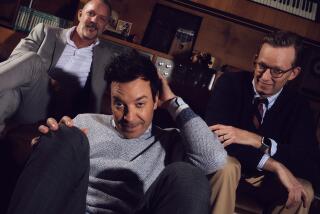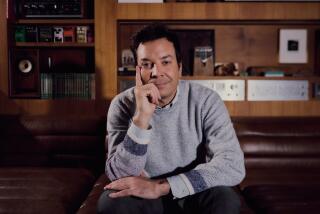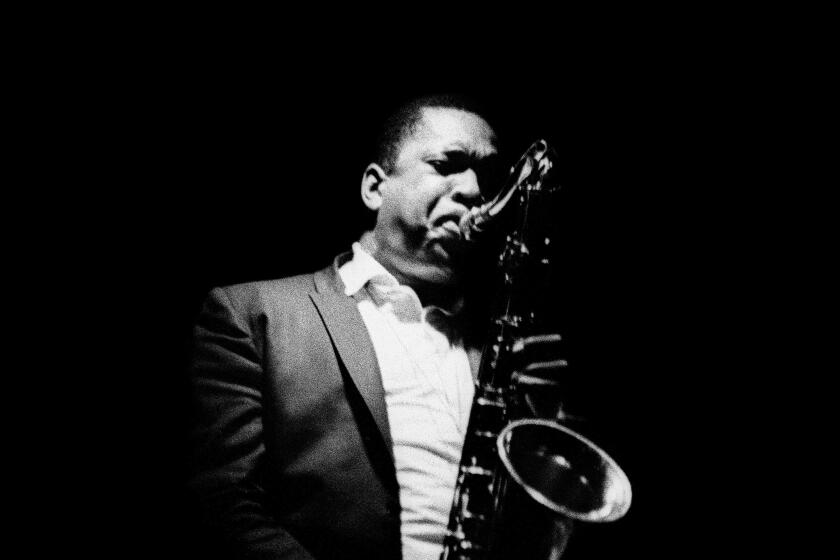‘Tonight Show’ Drummer Marches to a Different Beat
- Share via
Ed Shaughnessy, the animated, energetic man who’s been sitting in the drum chair of “The Tonight Show” Orchestra since 1963, is not shy about telling a visitor that he has one of the great jobs in music.
“You come in, rehearse, do the show and in 3 1/2 hours, you’re free for the night,” he said over a cup of coffee in the kitchen of his Woodland Hills home. “After 23 years, it’s not dull.”
Not that working the show’s a snap. “You always have to play for new people every day, so you never know what you’re going to do when you go in,” Shaughnessy said. “That’s challenging. Since I get everything from Top 40 to funk to you name it, I have to stay tuned in to the current rhythms, because what was hip five years ago is not hip now.”
And while he likes the fact that the band stays fresh as new charts by such craftsmen as Bill Holman, Tommy Newsom and John Bambridge are regularly brought in by leader Doc Severinsen, Shaughnessy said, “I’d like it if the band got to play more. Except for featured on-camera numbers, we rarely get to play a tune all the way through.”
To “play some creative music and to do more of what I want to do at greater length,” the drummer formed a quintet two years ago. The group, which features “Tonight Show” members Tom Peterson on saxes and Bruce Paulson on trombone, plays Mondays at Le Cafe throughout November.
Shaughnessy said there’s quite a difference in approach between backing a big band and working with a small group.
“In big band playing, you’re the guardian of the time (tempo), because there are so many players and things that tend to pull or push at it,” he said. “It’s essential that you establish a good strong center and a good strong drive, because you have to get the people moving, even if they don’t want to. Since you’re hewing a fine line between strength and musicality, it’s a job where the ‘how’ is much more important than the ‘what.’ ”
In small group playing, “It’s more about establishing a groove, because the time is not going to be pushed and pulled by so many things,” he said. “There’s great joy in getting a good groove together--that’s what rhythm playing is all about.”
The 56-year-old native of Jersey City, N.J., based his quintet on the instrumentation of a band he worked with in New York in the early ‘50s, when he was mainly a combo drummer.
“It was led by trombonist Bill Harris and featured saxophonist Zoot Sims and pianist Horace Silver, and it was one of the best things that ever happened to me,” he recalled. “You didn’t really have to play rhythm, because everybody had such perfect time. So that trombone-tenor sound has stayed with me.”
Shaughnessy said one of the reasons the small band sounds good to him is that “we all like each other a lot. I’m a big believer that if you like each other off the stand a lot, you communicate better on it.”
One aspect of his current fivesome that particularly pleases Shaughnessy is that there’s “a little more elasticity, more stop-and-go in the rhythm section,” he said. “For example, maybe we don’t play the same time feeling all through the song. Maybe the drums drop out, and the bass duets with the horns, or maybe we go into a 6/4 meter against the basic 4/4 and change the groove. I think this is interesting for both musicians and listeners.”
The drummer, who began playing the trap set at age 14, got his first professional job through serendipitous circumstances in New York. “I was 18, when I sat in one night with (seminal be-bop pianist) Bud Powell on 52nd Street,” Shaughnessy recalled. “We played ‘Cherokee’ for 35 minutes. It was great. Bud never looked at you, he just kept going. And then later, he told me quietly, ‘Good.’ One word.”
George Shearing was in the audience that night, and “he gave me a gig because of it. I had been trying to break in, but then, if you were from New Jersey, coming into New York an unknown was just like coming from Iowa.”
Shaughnessy, who played in small bands with Charles Mingus and Coleman Hawkins, said his small-group career was on the wane and he was playing a lot of commercial recording dates when he got the call from then-leader Skitch Henderson to do the “The Tonight Show.”
“I didn’t think I wanted to do it steady, so I asked for a two-week trial,” he said. “But when I got there, there was Clark Terry, and Doc is playing lead. Severinsen took over the band in 1967 and God, it felt so good, the band was so high class, I stayed.”
More to Read
The biggest entertainment stories
Get our big stories about Hollywood, film, television, music, arts, culture and more right in your inbox as soon as they publish.
You may occasionally receive promotional content from the Los Angeles Times.










